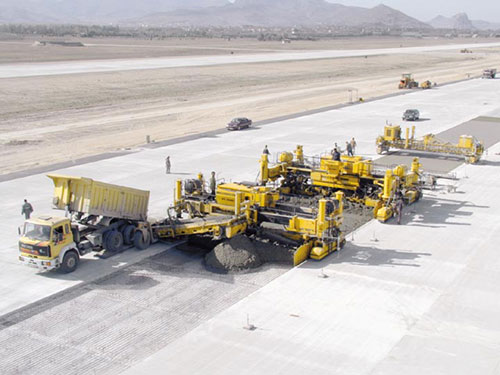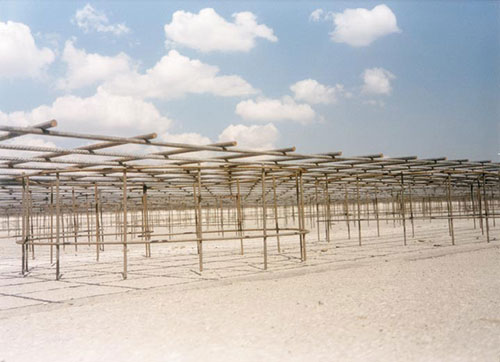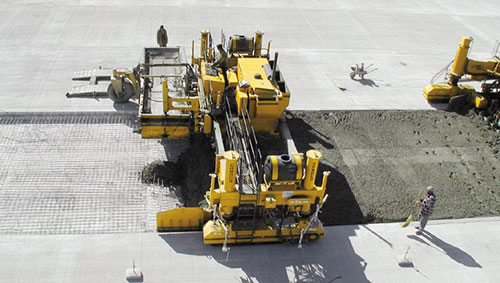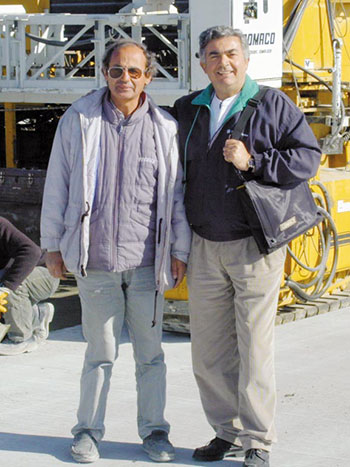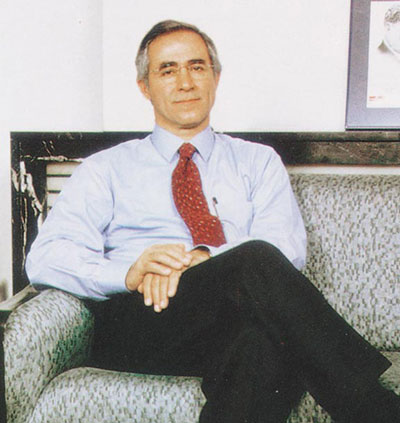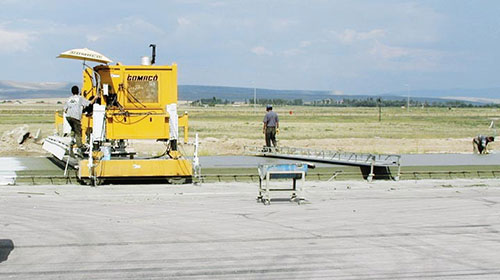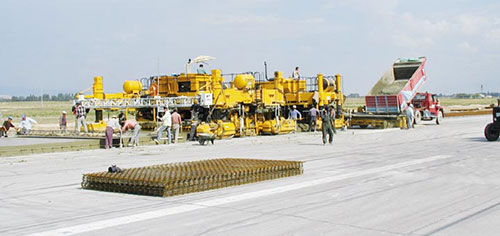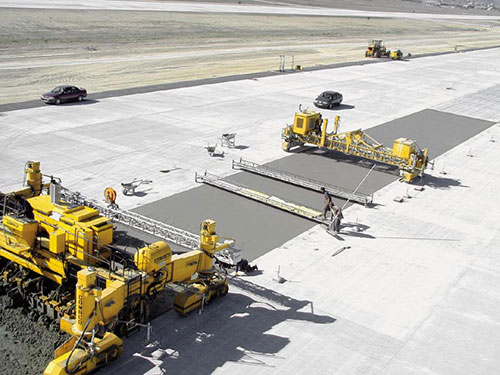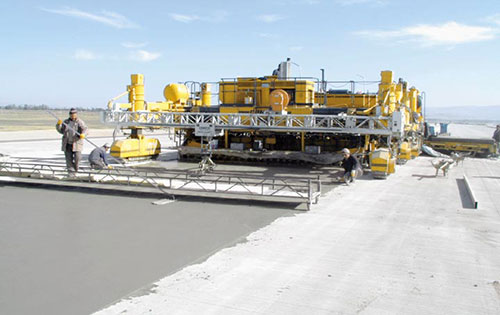GOMACO World Index --- GOMACO World 28.1 - May 2000
Finally Slipforming
Editor's Note: A special thank you on this story to Ilhami Kilicoglu of Intop, GOMACO's dealer in Turkey, for making this article possible and for providing the interviews.
Two contractors in Turkey have broken away from the standard practice of paving over forms and are introducing the country to slipform paving. Maktas A.S., based out of Istanbul, and Yenigun Construction Company in Ankara both recently purchased GOMACO GHP-2800 slipform pavers.
Neither contractor has wasted any time putting their machines to work and both are currently paving airport projects in Turkey. Both contractors are pioneers in their fields and this is the first time concrete runways have been slipformed in Turkey.
One of the contractors began work in April 1999, using a GOMACO paving train consisting of a PS-2600 placer/spreader, a GHP-2800 paver with AutoFloat®, and a T/C-400 texture/cure machine. The project was carried out as part of a program to improve airport facilities in Turkey.
"The objective was to increase the carrying capacity of runways for the landing of heavier carrier aircraft," Erdogan Aksoy, concrete works subcontractor, said.
Two new parallel runways were slipformed 9843 feet (3000 m) long in six separate passes of 24.6 feet (7.5 m) for a total width of 147.6 feet (45 m).
The unique aspect of the project is the mesh reinforcing being used. "The purpose of the mesh is to prevent the movement or reflection of the slab and to stop cracks from developing like they did in the existing slab," Aksoy said.
The contractor felt a placer/ spreader was necessary because of the steel mesh. "The steel mesh was part of the reason behind the purchase of the PS-2600," Aksoy said. "It improved our efficiency and increased our productivity and we were pleased with its performance.
"We liked the side feed of the concrete with the placer's conveyor. It made placing the concrete very easy and the belt handled the concrete load well," Aksoy said. "We also like the auger for the spreading function which spreads the concrete evenly on the grade and it's easier to regulate the amount of concrete in front of the paver."
The only problem they encountered with the operation of the PS-2600 was with their dump trucks. The height on the truck chassis was too low to tip the concrete onto the conveyor belt's hopper. To solve the problem, the contractor made a ramp, attached wheels to it, and attached it to the front of the placer/spreader. The trucks could then back up the ramp and dump their load into the hopper.
A special concrete mix design made up of local aggregates with an air entrainment agent was used to slipform the runway. Many tests had to be carried out to perfect the mix.
Project specifications required the mix to meet a minimum strength requirement of 640 lbs/in2 (45kg/cm2) for 28 days. The required specifications were easily met.
Expansion joints were placed in the slab every 328 feet (100 m). Average concrete slump was one to two inches (25 to 50 mm).
"Consistent slump of the concrete is the secret in slipforming," Aksoy said. "Once we had nearly 100 percent control of the slump and could get consistent slump to the paver, there was nothing more pleasant than to slipform concrete with this machine."
Production rates varied on the project because of the concrete supply.
"The biggest problem on the job was the batching plant could not produce enough concrete to run the paver faster," Aksoy said. "We had a batching plant with a practical capacity of 131 yd3 (100 m3) per hour. Working 10 hours a day, we were forced to pave only 1247 feet (380 m) on the average because of this limitation."
A T/C-400 completed the paving train and put the final textured surface on the runway.
The contractor is enjoying their new equipment and the results they are getting on rideability.
"The required rideability was a maximum of six inches (150 mm) per mile. We achieved three inches (75 mm) per mile," Aksoy said. "We could hardly achieve between four to six inches (100 to 150 mm) per mile with the fixed-form method."
The contractor credits their rideability success to several things. "First of all, it is a team effort," Aksoy said. "All the members of the slipform team starting from the batch plant operator, the truck drivers, the operators of the placer/spreader, paver, and texture/cure machine, and finally the hand-finishing labor, all must have the urge and eagerness to achieve rideability and smoothness."
Concern about rideability was one of the major issues the contractor wanted to address when they purchased a new paver.
"We wanted to adapt to the new technologies governing concrete pouring methods," Aksoy said. "We had the desire to achieve better rideability and smoothness and also to be able to pave more meters per hour.
"Through the years Ilhami Kilicoglu, GOMACO's dealer in Turkey, was constantly paying visits to various job sites, organizing seminars and explaining the benefits contractors would get if they started with slipforming."
Aksoy also visited GOMACO's factory in Ida Grove, Iowa, and the GOMACO booth at various trade shows to learn more about the slipforming process.
"GOMACO showed us clearly that they integrated the slipform technology into their machines and developed slipform paving to the highest standards," Aksoy said. "There was confidence and trust on both sides."
The project was completed in December 1999. A total of 176,572 yd3 (135,000 m3) of concrete was slipformed on the project.
Yenigun Construction Company, as part of the joint-venture team of A.N.O. and Erkem J.V., started work on a runway project in February 1999.
"The project is part of a program to improve and renew airport facilities in Turkey," Anil Kral, assistant project manager, said. "This project will increase the carrying capacity of the runways."
The runway was slipformed on a newly prepared lean-concrete subbase. The overall pavement is 147.6 feet (45 m) wide by 9843 feet (3000 m) long. The runway was paved in six separate passes of 24.6 feet (7.5 m). Approximately 61,800 yd3 (47,250 m3) of concrete was placed on the project.
Concrete was delivered to the site by rear dumper trucks. A rubber-tired excavator was used to spread the concrete in front of the paver.
"The best day of production we had was around 984 feet (300 m)," Kral said. "We had a batching plant with a capacity of only 105 yd3 (80 m3) per hour so we had to adjust our working speed accordingly. Because of this limitation, we only averaged about 820 feet (250 m) per day."
A concrete mix design made up of local aggregates with an air entrainment agent was used to slipform the runway. Slump averaged between one to two inches (25 to 50 mm). Expansion joints were placed every 328 feet (100 m).
A GOMACO T/C-400 texture/cure machine put the final touches on the runway. "We like the speed and consistent operation of the T/C-400," Kral said. "It is also possible to obtain 9.84 feet (three meters) of uniform, textured surface with every single pass."
Yenigun also achieved superior rideability that was well under the project specifications.
"Constant slump of the concrete is essential for good rideability," Kral said. "Good topographical setup of the stringline is also important because the paver uses automatic grade and steering control."
Learning the slipforming method has been a relatively easy process for Yenigun. "We did some trial tests and took the time to adjust the mix design and let the operators gain confidence," Kral said. "After completing a couple of 328 feet (100 m) concrete pour trials, everything ran very smoothly."
Engineers at Yenigun worked closely with Ilhami Kilicoglu, GOMACO's dealer in Turkey, on purchasing the slipform paver.
"Mr. Kilicoglu convinced us to stop using the fix-form machines and start with the new technology," Mithat Yenigün, president of Yenigun Construction Company, said. "We wanted a paver that was compact and ergonomic with optimum dimensions." The new pavers are replacing 40-year-old fix-form machines.
Yenigun's next project with their machines will be completing the second stage of the Erkilet runway project at Kayseri. After its completion, they plan on slipforming more airport projects in Turkey and the surrounding countries.
Both contractors are looking forward to introducing the slipform technique to the Turkish Highway Department. They hope their efforts will lead to concrete roadways in Turkey.
Subscribe to Receive GOMACO World Magazine
